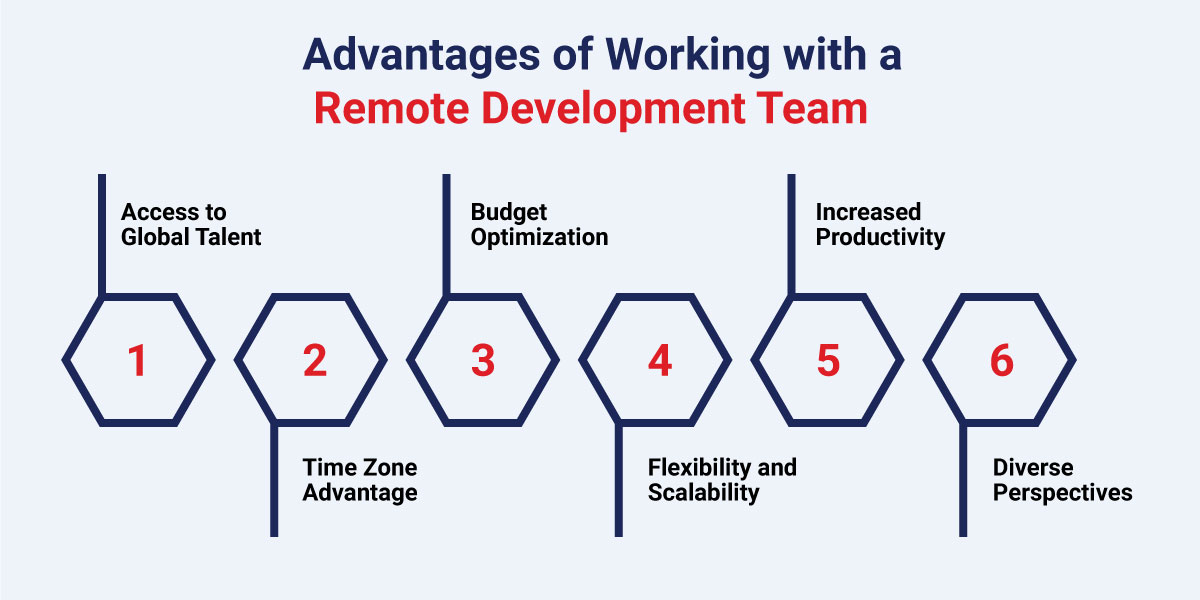The global software development market, roughly worth $595 billion now, is expected to hit $812 billion by 2027. [1] The market is booming, and the numbers indicate the demand for development teams will only rise. Now more than ever, companies of all sizes are leveraging remote workforce. It allows them to benefit from a global talent pool by hiring tech professionals from various locations worldwide to achieve their business goals on time and within budget.
And as suggested by several research reports, remote work is here to stay & companies must make necessary adjustments to remain successful. Fortunately, the recipe for managing a remote software development team is simple. With over two decades of experience in custom software development, we’ll share our time-tested knowledge on managing a remote development team, mitigating the risks of working with remote developers & tips for ensuring efficient project management.
Let’s start!
What is a Remote Software Development Team?
A remote software development team comprises a diverse talent pool from different locations. Famous in the information technology industry, this cost-effective & time-efficient model is an excellent solution for companies looking to tap into global talent, reduce their development costs, or keep up with dynamic trends. It is a cooperation model where your chosen technology partner provides a virtual team that collaborates remotely to design, develop, and deploy your software product. This flexible arrangement allows you to scale up or down as needed.
Famous Companies Managing Remote Teams Effectively
The model to manage remote software development teams is not restricted to US-based startups or Western European companies alone. Listed below are examples of some of them who are capitalizing on this profitable trend:
- Automattic is the parent company of WordPress, WooCommerce, Longreads, Gravatar, and Tumblr has a distributed workforce and hires remote developers. Over a thousand employees are spread across 77 countries, speaking 96 different languages.
- Todoist, a popular productivity tool, is powered by the team at Doist, currently assisting over 22 million individuals in managing their tasks and projects. Doist’s team spans globally, from Jamaica to Poland, Taiwan to Australia.
- Toptal, one of the largest fully remote companies, boasts a core team comprising hundreds of members in 70+ countries. Initially catering primarily to tech talent, Toptal has expanded its talent pool to include designers, writers, and more. The company’s unique selling proposition lies in its rigorous selection process, accepting only 3% or fewer freelance applicants.
- Shopify is an e-commerce company that empowers online businesses to sell, market, and effectively manage their products. With a workforce exceeding 7,000 employees, Shopify has established itself as a prominent player in the industry.
- Knack is a cloud-based tool that simplifies application development for businesses, enabling them to manage, share, and leverage data efficiently. With a distributed team of 31 members across the globe, Knack boasts a customer base of over 4,000, who have collectively built over 100,000 applications.
Benefits of Working with a Remote Development Team
Businesses invest significant time, resources & efforts in building and managing remote software developers. They can help them keep up with ever-evolving technology requirements.

Let’s discuss some of the essential advantages of working with a remote development team in 2023;
- Access to Global Talent: By embracing the remote revolution, you open doors to a vast talent pool worldwide. You can hire skilled professionals regardless of geographical limitations, giving your business a competitive edge. It helps expand options to look for the right expertise & experience as per the project requirements.
- Time Zone Advantage: By working across different time zones, remote team management enables projects to progress around the clock, allowing faster development cycles, reduced turnaround times, and improved responsiveness to client needs.
- Budget Optimization: Remote team management comes with cost advantages. And the functional teams often are from countries with lower labor costs, allowing you to potentially reduce salaries, benefits, office space, and equipment expenses.
- Flexibility and Scalability: Managing a remote development team allows you to scale your workforce based on project requirements. Whether it’s a small or large-scale project, you can quickly adjust team size without the hassle of hiring or downsizing.
- Increased Productivity: Remote developers are known for their focus. They often provide fewer distractions compared to traditional office settings. With dedicated spaces and fewer interruptions, remote developer teams can work with increased focus and productivity. Further, remote teams are also accustomed to using collaboration tools effectively, streamlining communication and task management. It would result in higher productivity levels and quality output.
- Diverse Perspectives: Remote teams bring diverse cultural backgrounds and experiences. This diversity fosters innovation, creativity, and fresh perspectives, leading to better problem-solving and enhanced decision-making.
In-House vs. Remote Development Team
When deciding between an in-house and a remote development team, weighing the pros and cons is essential. Let’s explore both options with their advantages and limitations:
In-House Development Team
Pros:
- Direct Control: Offers direct control over the work, allowing immediate feedback and seamless collaboration.
- On-Site Collaboration: In-person interaction promotes quick problem-solving and seamless communication and fosters a strong team culture.
- Team Cohesion: Being physically present in the exact location facilitates team bonding and a sense of camaraderie.
Cons:
- Higher Costs: These come with additional expenses like salaries, office space, equipment, and employee benefits, which can strain your budget.
- Limited Talent Pool: Geographical limitations may restrict your access to specific skill sets, limiting the talent you can recruit.
- Fixed Work Hours: Typically follow standard office hours, which may not accommodate urgent or time-sensitive tasks outside those hours.
Remote Development Team
Pros:
- Global Talent Access: Allows tapping into a global talent pool to find the right skills and expertise without geographical constraints.
- Cost Savings: Offer cost advantages by eliminating expenses like office space, equipment, and employee benefits.
- Flexibility and Scalability: Can adapt to project demands more efficiently, allowing for quick scaling up or down as needed.
Cons:
- Communication Challenges: Working across different time zones and relying on digital communication tools may pose challenges in collaboration and understanding.
- Limited Face-to-Face Interaction: Might lack the in-person interaction that fosters strong team dynamics and camaraderie.
- Dependency on Technology: Relies heavily on technology, and any technical issues can hinder productivity if not addressed promptly.
Ultimately, the choice of how to manage a remote development team depends on your needs, budget, and priorities. You must carefully consider these factors to make an informed decision that aligns with your business needs, goals, and budget. Here’s a complete guide on “How to Outsource Product Development in 2023”. It covers everything you need to know about outsourced product development.
Tips for Effectively Managing Remote Software Development Team(s)
Here are some tried-and-tested advice on how to effectively manage a remote development team:
1. Onboard a Competent Remote Development Team
Effectively managing a software development team remotely would require a thoughtful approach to ensure a smooth transition and productive collaboration. Follow these steps for responsible remote development team onboarding:
- Find the Right Fit: If working with a technology partner, look for a company with software developers who possess the required tech skills and align with your company’s values.
- Transparent Communication: Discuss the collaboration model and establish clear expectations. Openly communicate tasks, deadlines, and compensation to develop a roadmap for a successful partnership.
- Prepare Your Team: If remote specialists work alongside your existing team, ensure a smooth transition. Redistribute processes, use collaboration tools, and incorporate team-building activities to foster a cohesive work culture.
- Early Preparations: Arrange everything before your new team members begin their work. Provide access rights, share important documents, set up accounts, and notify relevant departments. If you are outsourcing, they’ll handle these tasks for you.
- Seek Feedback: Foster seamless communication via video conferencing, instant messaging platforms, and project management software. Encourage regular check-ins, team meetings, and one-on-one sessions to ensure everyone stays connected and aligned.
2. Define Accurate Roles and Responsibilities
Your remote development team is like a dream team, bringing together diverse professionals to create extraordinary software solutions. Here are some key roles you’ll typically find in such a team:
- Product Owner: This role brings your business needs to life by transforming them into concrete software requirements. They bridge the gap between your vision and the development team, ensuring a clear direction.
- Product Manager: An experienced guide accompanying you throughout the product development journey. They provide invaluable insights, determine the product’s value proposition, and keep the development process on track.
- Project Manager (PM): The superhero who manages it all! The project manager takes charge of documents, budgets, and risks. They steer the ship, ensuring everything stays on track and aligns with your strategy.
- Business Analyst (BA): The BA dives deep into your project, collecting and defining the necessary specifications and setting the foundation for successful development.
- Software Engineers: These brilliant minds weave coding magic to build your product’s front and back end. Their expertise ensures your software functions flawlessly and delivers the desired results.
- Quality Assurance (QA) Engineer: This meticulous specialist ensures that your solution meets all requirements and works seamlessly. They test, identify bugs, and ensure your software performs at its best.
- UX/UI Designers: These creative souls make your product visually appealing and user-friendly. They craft stunning interfaces while keeping the end-users in mind, enhancing the overall experience.
- DevOps Engineers: These tech wizards handle the essential tools and processes behind the scenes. They automate code flow, set up the necessary infrastructure, and ensure smooth software development and deployment.
With this powerhouse team in place, you’ll have the expertise and skills needed to bring your software vision to life. Each professional plays a crucial role in building a robust and successful product that meets your business goals.
3. Streamline Processes and Procedures
Restructuring your team’s workflows can maximize productivity and create a conducive work environment to overcome challenges and deliver outstanding results.
- Map out Your Flow: Define the steps, dependencies, and handoffs involved. This way, everyone knows what’s coming and can collaborate seamlessly.
- Embrace the Right Tools: Adopt a user-friendly project management tool that combines everything. It’s your team’s virtual command center, ensuring everyone is on the same page.
- Time It Right: Set realistic timelines that consider your team’s capabilities and the project’s complexity. Avoid burnout and frustration by balancing deadlines with quality work. Time management is the secret sauce to hitting milestones successfully.
- Embrace the Agile Methodology: Break big tasks into smaller, achievable goals. Prioritize and adapt as you go. Agile keeps your team ready to tackle any challenge.
- Share the Know-How: Document your processes and best practices. Create a digital treasure trove of guidelines and coding standards. Sharing knowledge boosts efficiency and empowers the team.
- Encourage Collaboration and Knowledge Sharing: Foster a collaborative environment by providing opportunities for team members to share their expertise, learn from each other, and collaborate on problem-solving. Utilize virtual brainstorming sessions, pair programming, and code reviews to promote collective growth.
4. Select the Right Collaboration Tools
By harnessing the capabilities of collaboration tools, you’ll foster a culture of teamwork, boost productivity, and create an environment where innovation thrives. So, gear up, explore, and find the perfect collaboration tools to manage a remote development team successfully.
- Document Sharing: Look for tools that offer secure document sharing and collaboration features. Whether it’s Google Drive, Dropbox, or a project management platform with built-in file sharing, find a tool that suits your team’s needs and keeps everyone on the same page.
- Communication Champions: Explore various tools that facilitate real-time chats and video conferencing. From Slack to Microsoft Teams, find a platform that encourages collaboration, eliminates barriers, and makes your team feel connected, no matter where they are.
- Time and Task Management: Keep track of deadlines, assign tasks, and ensure everyone knows what they need to do and when. Look for project management tools with features like task tracking, Gantt charts, and milestones. Trello, Asana, or Jira are just a few tools that can help you stay organized and ensure that projects stay on track.
- Version Control and Code Collaboration: Version control and code collaboration tools are non-negotiable for software teams. Git, GitHub, or Bitbucket provide a collaborative environment where team members can work on code simultaneously, track changes, and merge updates seamlessly. These tools safeguard your code and make collaboration a breeze.
- Performance and Analytics: Track your team’s performance pulse with analytics tools. These gems provide insights into project progress, team productivity, and areas where improvements can be made. Tools like Toggl, Harvest, or Monday.com offer reporting and analytics features to help you make data-driven decisions.
5. Schedule Regular Meetings to Build Trust and Alignment Across Time Zones
Seamless communication is the backbone of any successful remote development team. Regular meetings are the key to keeping everyone organized and on the same page. But remember, it’s not just about control – building trust, checking progress, removing obstacles, and aligning plans. Here are some virtual meetings to consider:
- Backlog Grooming: Discuss items in the backlog and prioritize tasks for the next sprint.
- Weekly Planning: Define the essential tasks for the week from the backlog.
- Daily Stand-ups: Connect with your team daily, discuss tasks, and offer support when needed.
- Demo: Showcase completed work to the customer and celebrate milestones.
- Retrospective: Reflect as a team on the sprint, learn from mistakes, and plan improvements for the future.
Apart from formal meetings, don’t forget to nurture personal connections. Schedule informal one-on-one meetings regularly, creating space for casual conversation that goes beyond business matters.
6. Track Project Progress with Timelines
Understanding how your project is progressing is crucial. That’s why tracking productivity metrics is a game-changer. Here’s what you gain:
- Progress in Numbers: Get a clear view of your team’s progress through accurate data.
- Analyze Employee Performance: Dive into individual contributions and identify strengths.
- Team Values and Engagement: Assess each team member’s involvement and value.
Tracking empowers your organization with valuable insights and helps remote developers address issues. When it comes to project progress and time-tracking tools, you can consider these popular and preferred options:
- Jira: Though it may seem complex, Jira’s Kanban board functions are intuitive and widely favored by software engineers. It integrates seamlessly with other Atlassian products and Slack.
- Asana: Offering similar features at a more affordable price, Asana provides an enhanced user experience. It even has a free trial version for teams of up to 15 members.
You can also explore alternatives like Trello and ClickUp, as they offer similar features and may better suit your team’s size, pricing plans, and user-friendliness.
By implementing these proven tips, you’ll be on your way to effectively managing your remote software development team, realizing their full potential and achieving remarkable results.
In a Nutshell
While remote work can feel overwhelming, adhering to established procedures can inspire remote teams to actively engage and contribute to achieving collective business goals and objectives. And ultimately, the team’s performance plays a crucial role in the business’s overall success. However, independently hiring a remote developer can be expensive, time-consuming, and intimidating.
Managing remote developer teams can be easy and efficient by partnering with an experienced custom software development company like Rishabh Software. You can leverage their expertise, resources, strategies, and knowledge of the software development lifecycle to streamline workflows and ensure seamless coordination among team members. We can consult, guide & work with you in setting clear goals, establishing realistic timelines, and implementing efficient processes. You can count on us to optimize productivity, enhance communication, and mitigate risks, ensuring successful outcomes for your projects, regardless of geographical distances.
FAQs
Q: What are the best countries to hire remote development teams?
A: Regarding hiring remote development teams, several countries stand out for their talented tech professionals and comprehensive tech stacks. Some popular destinations include:
- India: With a vast talent pool and cost-effective rates, India is a destination for remote development. It’s renowned for its expertise in various technologies, including software development.
- Ukraine: Known for its strong engineering talent and competitive rates, Ukraine has become a hub for remote development teams.
- Poland: It has a thriving IT industry and a high level of English proficiency among its developers.
Q: What are the famous models for hiring a remote development team?
A: Two popular models for hiring remote development teams are:
- Dedicated Team Model: In this model, you hire a dedicated team that works exclusively on your project. You have complete control over the team’s composition, and they act as an extension of your in-house team.
- Project-Based Model: With this model, you hire a remote team for a specific project or task. Once the project is completed, the team’s engagement ends. This model offers flexibility and cost-efficiency for short-term projects.
Q: What is the biggest challenge in remotely managing a software development team?
A: It is about ensuring effective communication and collaboration. Miscommunication, lack of clarity, and coordination issues can lead to delays and misunderstandings. Managing expectations, setting clear goals, and utilizing communication tools are crucial for overcoming this challenge.
Q: List the most effective tools for managing remote developers.
A: Several tools facilitate the effective management of remote development teams. Here are a few popular ones:
- Project Management Tools: Platforms like Jira, Trello, and Asana help track tasks, assign responsibilities, and monitor project progress.
- Communication Tools: Tools like Slack, Microsoft Teams, and Zoom enable real-time communication, video conferencing, and file sharing, fostering collaboration among team members.
- Version Control Systems: Git and GitHub allow teams to collaborate on code development, track changes, and merge code seamlessly.
- Documentation and Knowledge Sharing Tools: Tools like Confluence and Google Docs facilitate documentation, knowledge sharing, and collaboration on project-related information.
Choosing the right combination of these tools based on your team’s needs and preferences will significantly enhance remote team management and productivity.
Footnotes:











 30 Min
30 Min


